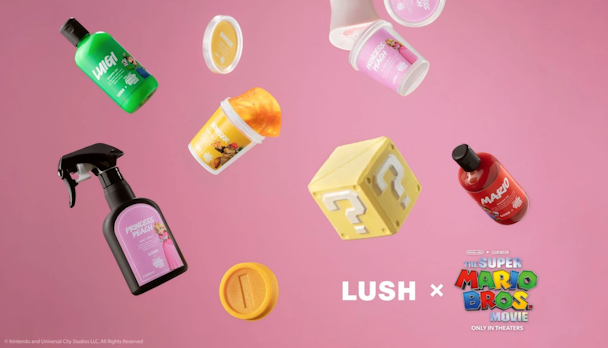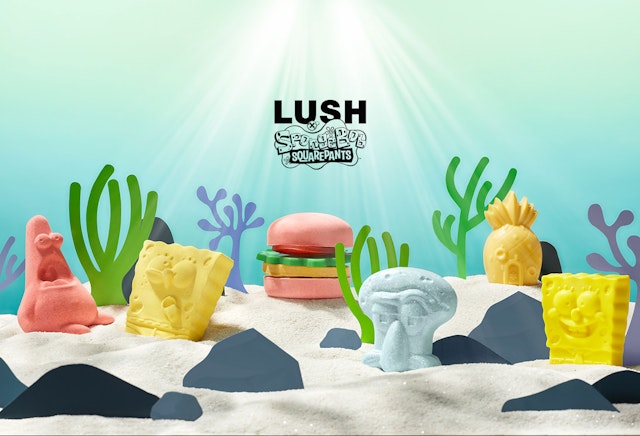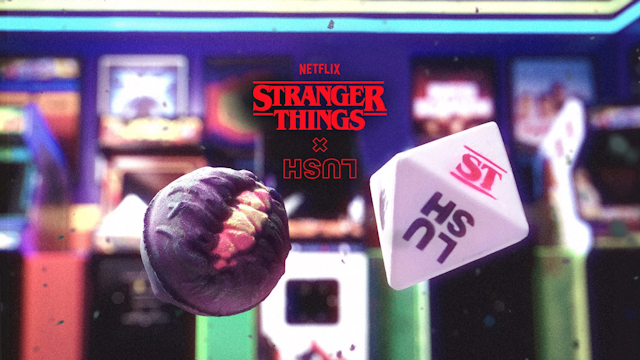Inside the Lush brand collaboration machine (that doesn’t rely on social media)
After ditching social media, the brand doubled down on forging collaborations with the likes of Netflix, Mattel, and Paramount to fuel excitement. Here’s how that plan has played out.

Lush
It’s been almost two years since Lush decided to stop putting marketing budgets on Facebook, Instagram, TikTok and Amazon. It’s since vowed to sever ties with Google, Apple and Microsoft by 2026. Soon, its reliance on big tech will be virtually non-existent. That raised the thorny question of how it remains visible on these digital channels and keeps its brand relevant. The answer to that problem was creating a ‘collaborations’ strategy that delivered over £15m in additional sales within 12 months and generated more excitement and searches for the company online than at any other point in its history.
Advertisement
Across the eight collaborations it’s launched this year, each has brought an average 30% increase in new customers. Overall, new customers shopping with Lush following the collaborations measured between March to June 2023 v 22 is up 11.2%. Meanwhile, 12-month rolling traffic to the Lush site is up 1.2% on the same time last year.
Its first licensed collaboration was with Japanese Anime One Piece. Lush Japan saw a 71% increase in new digital customers, and it sold out of all stock by 2pm on launch day.
Since then, the most successful have been, perhaps surprisingly, the SpongeBob SquarePants and Super Mario Bros limited ranges. The recent Barbie collab has also proven a hit, though numbers on how successful are still coming in as it continues with the roll-out in new regions.
“We probably didn’t think this would be that successful,” admits Annabelle Baker, chief brand officer at Lush, on how quickly it’s seen results from the new approach. “We knew there was a success to be had with [collabs] if done correctly and really looking at the creativity and the product to make sure it would resonate with a new audience as well as making sure there’s something in there for the existing customer.”
Advertisement
Equally surprising is the strategy (or lack of) that goes into deciding which brands or companies to collaborate with. Rather than analyzing data, investigating trends, and dissecting audiences to determine which demographics will engage with which potential partner brands, Baker says Lush takes a more intuitive approach.
Take its partnership with the Super Mario Bros movie, for example. Collaborating with gaming giant Nintendo on a product range that included a shower gel, body spray and gamified bath bomb was put forward by chief digital officer Jack Constantine and Melody Morton, who leads the collabs team. The collection achieved £10m in sales globally.

Or look at the SpongeBob SquarePants collection from earlier this year. The data alone might not have suggested that the Paramount kids' cartoon would be a good fit. Had the numbers been crunched, the collab would probably never have got off the ground. In the end, by tying it to a global ocean conservation and sustainability initiative, it generated over £1.3m in sales in the first week and over £4m globally to date.
“We definitely are not looking at data insights. But we do listen to staff, and staff have some specific requests about what they would like to see,” she says.
“[A collaboration] basically starts with someone who’s found something that’s kind of interesting or cool for us to look at. So, an idea, probably from somebody else within the business, or it can be the partner coming to us. And then it’s really about the creative process for the products because we’re not just doing licensing in the traditional sense. We really, really want to look at the creativity behind it and how we can elevate it.”
Suggested newsletters for you
Ensuring each collection offers something unique is only possible as Lush has control of its manufacturing processes, with product development sites in seven locations globally. This means Baker and her marketing team are working hand-in-hand with the manufacturing teams; they have a say in what gets developed, how it should be formulated, and what it should look like – not simply how it’s taken to market.

Marketing budgets that have supported these collaborations aren’t what you might expect either. Baker points to a rival beauty retailer that spends 17% of total sales on advertising.
"There’s this assumption that cosmetic brands or FMCG brands have vast volumes of cash to spend on marketing. And I can see why when you’ve got brands like L’Occitane saying they’re spending 17%,” she says.
“We’re nowhere near that. We’re low single digits because we put all the money into the products. We don’t have anywhere near that amount to spend. [L’Occitane] has got huge disposable income because, actually, the cost of goods is nothing. Whereas pretty much all our money goes into making our products.”
It has historically spent very little on above-the-line. Social media used to be a cheap alternative to reaching mass audiences, but it quit spending on those platforms last year, in part because it was failing to see the results from any investment.
“We’ve always relied on word of mouth, people loving the product and advocating for it. People buy from people and that’s really critical. We could have put [content] out there that’s super slick but we know that people actually just aren’t that interested in that type of content. And quite rightly so."
In short, these collaborations have been successful, she says, because it’s not relied on any paid-for marketing but invested in products that creators on social platforms will want to share with their audiences.
For example, in the UK, for the launch of Lush x Stranger Things, Lush had its most engaged tweet since the brand account was created in 2009, when posting a sneak peek. This particular collaboration required a speedy turnaround time of only six weeks, and in the end, the limited edition bathing products generated a 6% increase in sales.
Engaging new customers with a shiny brand collaboration is the easy part. Retaining them long-term is now the trickier job at hand for Baker.
“It’s been something that we’ve been trialing in terms of when they come back and how can we get them sampling, especially digitally. We’ve got a big opportunity to kind of like bring them back.”
It experimented with bringing back the special scents or dedicated range launched as part of a collaboration project into a permanent offering. “Like, oh you love the fragrance, so we are going to reuse it over here in this format. That’s one of the flexibilities we have at a company level.”
She says the collab collections attract people who wouldn’t usually buy at Lush. They are then so impressed by the product quality that they consider different categories.
“Strong cross-category purchasing was a big thing that we saw with Super Mario Bros. But I’m sure that’s not all that we can do because we’re still in our infancy.”

